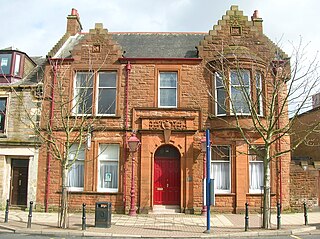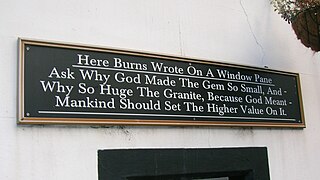
Scotland is a well-developed tourist destination, with tourism generally being responsible for sustaining 200,000 jobs mainly in the service sector, with tourist spending averaging at £4bn per year. In 2013, for example, UK visitors made 18.5 million visits to Scotland, staying 64.5 million nights and spending £3.7bn. In contrast, overseas residents made 1.58 million visits to Scotland, staying 15 million nights and spending £806m. In terms of overseas visitors, those from the United States made up 24% of visits to Scotland, with the United States being the largest source of overseas visitors, and Germany (9%), France (8%), Canada (7%) and Australia (6%), following behind.

Alloway is a village in South Ayrshire, Scotland, located on the River Doon. It is best known as the birthplace of Robert Burns and the setting for his poem "Tam o' Shanter". Tobias Bachope, the mason responsible for the construction of Hopetoun House, Craigiehall, and Kinross House, also hailed from Alloway. Some historic parts of the village make up a conservation area.
The Burns Club of Atlanta, officially organized in 1896, is a private social club and literary and cultural society commemorating the works and spirit of the 18th century national poet of Scotland, Robert Burns. In addition to holding monthly meetings, the club has held a Burns supper celebration on the anniversary of Burns' birthday every year since 1898. Club events are held in the Atlanta Burns Cottage, a 1911 replica of poet Robert Burns' birthplace in Alloway, Ayrshire, Scotland. The Cottage has been listed on the National Register of Historic Places as Burns Cottage since 1983.

The Alloway Auld Kirk, which dates back to the 16th century, is a ruin in Alloway, South Ayrshire, Scotland, celebrated as the scene of the witches' dance in the poem "Tam o' Shanter" by Robert Burns.

Burns Cottage, the first home of Robert Burns, in Alloway, South Ayrshire, Scotland was built by his father, William Burnes in 1757. Burns, Scotland's national poet, was born there on 25 January 1759. It is a four-roomed clay and thatch cottage and has been fully restored to become part of the Robert Burns Birthplace Museum.

The Burns Monument in Kay Park, Kilmarnock, Scotland, commemorates the poet Robert Burns (1759–1796). It is located at an elevated position within Kay Park, to the east of Kilmarnock Town Centre. The monument was opened in 1879, and is a category B listed building. In 2004, following years of neglect by the local council, fire destroyed most of the building. What was left of the monument was incorporated into the new Burns Monument Centre which opened in 2009. In 2010 the centre was shortlisted for the Carbuncle Cup award run by Building Design.
Robert Crawford is a Scottish poet, scholar and critic. He is emeritus Professor of English at the University of St Andrews.

Robert Burns, also known familiarly as Rabbie Burns, was a Scottish poet and lyricist. He is widely regarded as the national poet of Scotland and is celebrated worldwide. He is the best known of the poets who have written in the Scots language, although much of his writing is in a "light Scots dialect" of English, accessible to an audience beyond Scotland. He also wrote in standard English, and in these writings his political or civil commentary is often at its bluntest.

During the years 1781–1782, at the age of 23, Robert Burns (1759–1796) lived in Irvine, North Ayrshire for a period of around 9 months, whilst learning the craft of flax-dressing from Alexander Peacock, who may have been his mother's half-brother, working at the heckling shop in the Glasgow Vennel. Dr John Cumming of Milgarholm, a provost of Irvine, claimed that he had invited Burns to come to Irvine to learn flax dressing. During this time he made a number of acquaintances, befriended several locals and took regular walks into the Eglinton Woods via the old Irvine to Kilwinning toll road and the Drukken or Drucken (Drunken) Steps. Steps over the Red Burn and back via the site of Saint Brides or Bryde's Well at Stanecastle. Burns had several other connections with the Eglinton Estate and other branches of the Montgomerie family. He probably left in March 1782.

The Drukken, Drucken Steps or Drunken Steps were stepping stones across the Red Burn in Irvine, North Ayrshire, Scotland and are associated with Scotland's national poet, Robert Burns. Drukken is used on the commemorative cairn plaque, but Druken or Drucken may also be used.

Ellisland Farm lies about 6.5 mi/10.4 km northwest of Dumfries near the village of Auldgirth, located in the Parish of Dunscore, Dumfries and Galloway, Scotland. The complex is a museum in the farm Robert Burns built, lived in and farmed from 1788 until 1791. One of the earliest references to the site is in 1465. Cardinal Antonius confirming a Charter by the Monastery of Melrose of the adjoining property of Ellisland to John Kirkpatrick.

The Irvine Burns Club, based at the Wellwood Burns Centre & Museum, was founded on 2 June 1826 and is one of the world's longest continuously active Burns Clubs. At least five personal friends of Robert Burns were among the group of local gentleman, whose idea it was to form the club. Irvine in North Ayrshire is an old market town and port situated on the west coast of Scotland, approx 14 miles north of Ayr.

Robert Burns came to know James Cunninghamme, Earl of Glencairn in Edinburgh in 1786 through a 'Letter of Introduction' provided by Dalrymple of Orangefield who was married to Lady Glencairn's sister. The Earl received the poet warmly in his house and introduced him to his friends. One of several gifts from the earl to the poet was a diamond point pen, stylus, or cutter which he used to write upon many windowpanes and glasses, scribing verse, his signature, epigrams, or other writings for posterity. Many of these diamond-point engravings survive, some however are contentious as regards either their authenticity, meaning, or both.

Burns Clubs exist throughout the world to encourage and cherish the memory of Robert Burns, to foster a love of his writings and generally to encourage an interest in the Scots Language and Literature. An emphasis on encouraging the young to take an interest in Burns is found in most clubs through poetry, singing and other competitions. Once mainly existing as 'male only' clubs in the mould of the Tarbolton 'Batchelor's Club' most now welcome women as fellow members. Ladies Burns Clubs also exist such as the 'Irvine Lasses' that was established in 1975; it has appointed several male 'Honorary Lasses'.

Writers' homes are locations where writers lived. Frequently, these homes are preserved as historic house museums and literary tourism destinations, called writer's home museums, especially when the homes are those of famous literary figures. Frequently these buildings are preserved to communicate to visitors more about the author than their work and its historical context. These exhibits are a form of biographical criticism. Visitors of the sites who are participating in literary tourism, are often fans of the authors, and these fans find deep emotional and physical connections to the authors through their visits.
James Armour was a master mason and father of Jean Armour, and therefore the father-in-law of the poet Robert Burns. His birth year was shown here as 1730. The Scotland's People database has no record of this year of birth for a James Armour. Wikitree and several other data sources have his birth date as 10th/24th January 1731. The Scotland's People database has this record but showing his baptism on 24 January 1731. His birth on the original Old Parish Record is shown as 15 January 1731 to John Armour and Margrat(sic) Picken in Kilmarnock. James named his first son John which would normally be after James's father i.e. John. The chances of there being two James's born on exactly the same date exactly one year apart appear very remote and the naming of the first child seems to validate the conclusion that James Armour was born in 1731 and not 1730.

Alexander Cunningham was one of Robert Burns's closest friends from his time in Edinburgh. They stayed in contact, through at least 19 letters from the poet; and Cunningham was the ardent admirer who encouraged and joined others such as John Syme to raise funds for the poet's family after his death. Cunningham was one of the small group of associates whom Burns actively approached for constructive criticism of his work.

James M'Kie or James McKie (1816–1891) was an apprentice of Hugh Crawford, John Wilson's successor at the Kilmarnock Cross printing business. In 1867, M'Kie published the first facsimile edition of the 1786 "Kilmarnock Edition" or Poems, Chiefly in the Scottish Dialect as well as various bibliographies, reprints, special editions, limited editions, etc. of Robert Burns' and other works for the Scottish, British, British Empire or North American markets. He became an avid collector of Burnsiana and put together the largest collection of published in the world at the time, that was eventually purchased by the local Kilmarnock Corporation and housed in the Kay Park Burns Museum.

Robert Graham of Fintry was the 12th Laird of Fintry near Dundee and was one of Robert Burns's most supportive patrons, correspondent and loyal associate. Appointed a Commissioner of the Scottish Board of Excise he assisted Burns with his Excise career and during his 'loyalty' difficulties. He was a great admirer of his poetry and Burns wrote several epistles to him. Burns referred to him as "Friend of my Life - True Patron of my Rhymes."
In 1834, Robert Burns' skull was exhumed and multiple casts were made from the head of Scotland's national bard.

















